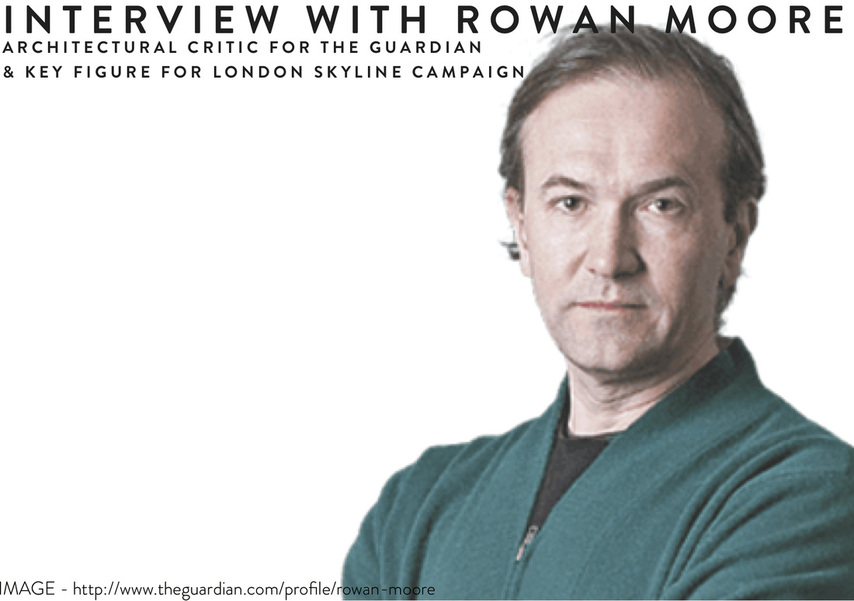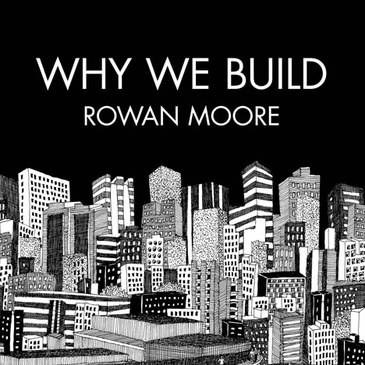|
As part of my research for my dissertation I interviewed Rowan Moore, architectural critic for the Guardian and leading role in the London Skyline Campaign. I carried out this interview for a contrasting point of view to my interview with Peter Rees, (Chief planning officer for the City of London from 1985-2014). For my dissertation I won the Architecture Dissertation Prize and have since been nominated for the RIBA Medal. |
Rowan Moore is an architectural critic and journalist who works for the Guardian. In the past he has worked for the Observer and the Evening Standard. He was once the director of the Architecture Foundation and has written an array of books, such as 'Why We Build', which is part of the bibliography for my thesis. Along with Barbara Weiss, he has championed the London Skyline Campaign which concerns the 200+ towers proposed in London.
I was unable to meet him in person due to his packed schedule. Nonetheless, after reading his book, 'Why We Build,' and some of his articles, I still had some questions. Therefore, I sent him some questions via email.
I was unable to meet him in person due to his packed schedule. Nonetheless, after reading his book, 'Why We Build,' and some of his articles, I still had some questions. Therefore, I sent him some questions via email.
INTERVIEW
WHEN I MET PETER REES, HE DEFENDED THE VIABILITY OF THE CLUSTER AND HIGH-RISE DEVELOPMENT IN THE CITY, BY SAYING ENSURING IT WAS A RESPONSE TO THE DEMAND FOR OFFICE SPACE IN THE CITY. CAN THE DEMAND BE MET THROUGH ANY OTHER MODEL?
Firstly, in principle, I am not opposed to the cluster of towers in the City. This is a good location for tall buildings. However, the argument that they are commercially necessary is not obvious.The total amount of additional floorspace created by going high is quite small. Tall buildings have not proved particularly profitable or easy to let. Because they are difficult and slow to build, they are unresponsive to the market – the Cheesegrater for example took more than a decade from conception to realisation. The exception is the Walkie Talkie, which I believe is proving very profitable. Unfortunately, it is also the most visually damaging. The argument for them is more to do with imagery and prestige. It is believed that they communicate that the City is a modern financial centre.
DO YOU THINK THAT CANARY WHARF COULD / SHOULD HAVE REPLACED THE CITY?
No. In fact they complement each other. Together they are very successful in making London into such a powerful financial centre, partly because they offer different types of environment and accommodation.
WHERE DO YOU STAND IN TERMS OF THE UNIQUE FORMS OF THE CITY TOWERS? AS OPPOSED TO THE MORE FUNCTIONAL ONES IN CANARY WHARF?
Differentiation between the City and Canary Wharf is positive. However, I think the attempts for the towers in the City to be distinctive, excessive. Whereas the Canary Wharf towers are a little too monotonous. To this extent they could learn from each other.
DO YOU THINK SKYSCRAPERS SHOULD BE BUILT IN ISOLATION OR IN CLUSTERS?
In general clusters are a safer bet. They are a simple way of giving order to tall buildings, and of managing their impact on sensitive areas. However isolated towers can also be effective, as with Centre Point/BT tower/Euston Tower standing apart from each other. What matters most is a coherent idea, or a set of ideas, across a whole city, of where towers might go and the principles that guide their design.
DO YOU THINK LONDON PLANNERS HAVE BECOME TO OBSESSED WITH 'SKYLINE'?
Not enough. At least they have not been effective enough in managing the skyline well. There can be an excessive tendency for the debate to focus too much on picturesque views in London for example, compared with the experiences of being within urban spaces created by any kind of new building, tall or not. Current tall building proposals are a symptom of weakness in the planning system – ultimately the latter is the more significant issue.
WOULD BRITISH PLANNING CULTURE BENEFIT FROM A MORE PROACTIVE APPROACH?
Yes it would, although not easy to achieve.
'TALL BUILDINGS SHOULD BE WELL-DESIGNED AND IN THE RIGHT PLACE.' - HAS THE CITY CLUSTER OBSERVED THIS?
'In the right place' – yes, with the exception of the Walkie Talkie. (Which sits outside the cluster.)
'Well-designed' – something like the Cheesegrater is well designed in the sense that a lot of consideration is given to its structure and detail. It has formal coherence combined with a certain boldness. However, the Cheesegrater, and other towers, are not well designed in the sense that they have little interest in their relationships with each other, and the way they combine to form and urban whole.
WHEN I ASKED PETER REES; 'DOES THE CHEESEGRATER, WITH ITS SHRINKING FLOORPLATES AS YOU ASCEND, MAKE SENSE ECONOMICALLY?' HE REPLIED SAYING; 'THAT WAS THE ONLY WAY TO BUILD A TOWER ON THAT SITE.' - DO YOU THINK REES AND THE CITY WERE EVER BUILDING TALL FOR THE SAKE OF IT?
I would say that both Rees and British Land wanted the Cheesegrater because they wanted to build a tower. There were certainly other and cheaper ways to achieve this much floorspace on the site. To this extent they were building tall for the sake of it.
WOULD YOU BE SURPRISED TO SEE THE CITY CLUSTER EXPAND OUTWARDS WITHIN THE CONFINEMENTS OF THE VIEWING CORRIDORS?
I expect the viewing corridors will continue to be challenged in the future. However I think the most contested zones will be outside them. To some degree viewing corridors suit most parties – they are well-defined policies that allow a great deal of freedom outside their boundaries, which is most of London. They therefore create a reassuring impression that planning is taking place, while allowing a lot of, often ill-considered, development.
|
I HAVE EXTRACTED SOME RELEVANT QUOTES FROM ROWAN MOORE'S BOOK, 'WHY WE BUILD,' WHICH I HAVE SHOWN BELOW; ‘It was repeatedly asserted that London’s status as a ‘world city’ would be endangered by a failure to build high.’ – referring to Ken Livingstone’s aspirations for London. ‘High density can be achieved without towers, and they are expensive to build.’ ‘Politicians, developers, and architects all like towers, as it makes them look purposeful, and imprints their actions forever on the skyline.’ |




